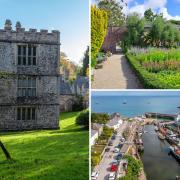Almost a third of Cornwall sits in an area of outstanding natural beauty. We continue our series exploring it. This month: Carnewas to Stepper Point.

IT IS along this stretch of coastline you will find the spectacular Bedruthan Steps, a popular attraction for visitors and artists. The steps provide access to a series of rocky beaches which become exposed at low tide. The beaches themselves do not provide safe bathing as there are heavy rips and fast tides with submerged rocks.
There is evidence of habitation in this area dating back to the Bronze Age as well as the remains of Redcliff Castle which dates backs to the Iron Age. The National Trust manage this section of the coast and the National Trust Shop and Tea Rooms are based in what was originally the Count House’ (office) and Mine Buildings of the Carnewas Mine. Bewteen 1871 and 1874 tons of brown haematite was extracted at Carnewas and it is thought that the ladders and steps to the beach were needed to reach the mine workings.
The impressive rocky stacks you will see at Bedruthan all have their own names and from north to south these are; Queen Bess, Samaritan Island, Redcove Island, Pendarvas Island and Carnewas Island with Samaritan Island being so called after a ship called The Good Samaritan foundered against the rocky stack in October 1846.
Moving on from Carnewas towards Stepper Point, this section of coast contains more than its fair share of sandy beaches including Porthcothnan, Treyarnon, Constantine, Booby’s Bay, Mother Ivey’s, Harlyn Bay, Hawkers Cove and Harbour Cove. There are only a few small villages throughout this section but plenty of opportunities to walk along the coastal path from beach to beach - and if you are feeling energetic ending up at Stepper Point which provides excellent views of the Camel Estuary up to Padstow and the Doombar.

The youth hostel at Treyarnon is situated just 50 metres fromthe sea and offers good family
accommodation. The hostel has everything you need during your stay including a café/restaurant and its
own ice cream shack. The Treyarnon youth hostel also offers several camping pitches and for those who
preferglamping’some luxurious bell tents. There are other small campsites along this section of the

Cornwall AONB offering pitches for both tents and caravans as well as a selection of hotels and B&Bs, to suitall budgets and providing ideal vacation destinations for families.
The Carnewas to Stepper Point section of the Cornwall AONB with its rugged Atlantic Coast gives rise to
many a tale of smugglers, with contraband being storedin Vougghas or Fogous (caves that were artificiallyconstructed for the stowing away ofrun’goods). The traditional stereotype of the Cornishman—taciturn,suspicious of strangers and rather secretive—owes a lot to the area’s reputation in the free trade.
In reality, the men of Cornwall probably smuggled muchless than their contemporaries in the south east ofEngland. The crossing to the continent was very muchfarther; the market for smuggled goods was strictlylocal and there were fewer suitable landing places onthe south west coast.
Getting out and about
Most visitors to this section of the Cornwall AONB come for the walking or to spend time at the many beaches which are ideal for families with young children, as well as surfers and body boarders.
The South West Coast Path offers a variety of walks for differing levels of ability (see ).
Cornwall Council offers a Rover’ Parking Permit which provides access to some (but not all) Cornwall Council controlled car parks (head to for more information).
i-walk Cornwall provides lots of useful information about walks within the Cornwall AONB - check out their website for information on walks in this area.
First Group (No. 556) operates the public bus service which runs at regular intervals between Newquay and Padstow along the length of the Carnewas to Stepper Point section of the Cornwall AONB.
WILDLIFE: What to look out for
This spectacular length of coastline experiences all the ravages of the Atlantic storms with high cliffs providing perfect vantage points for nature watching.
On the land
The shrill call of the skylark is regularly heard along the high cliff tops and walkers are reminded to always keep dogs on leads to avoid disturbing ground nesting birds. The rare Corn Bunting may occasionally be sighted along this section of the AONB where arable farm land extends towards the cliffs. Trevose Head is also an ideal spot for sightings of many migrant species of birds as they make landfall.
At sea
Common and bottlenose dolphins and very occasionally the Risso’s dolphin can all be sighted along this stretch of coast as well as basking sharks and grey seals and the random Minke whale. In the summer months it is also possible to see oceanic sunfish feeding just beneath the surface of the ocean.
Expect to see Cormorants, Shag, Guillemot, Razorbill, Fulmar, Gannets, Ravens and Kittiwakes throughout the year with the best times for sightings being during strong west to north easterly onshore winds when many species normally found out at sea being carried closer to the shore.
When the conditions are right, this section of the Cornwall AONB can provide some of the best bird watching in the British Isles with not only a range of the more common species but also an opportunity to spot some rarer birds.
In the air
In warmer weather this stretch of coastline provides a perfect habitat for many resident rare and common butterflies as well as migrant species. Expect to see Painted Ladies, Clouded Yellows, Brimstones, Red Admirals and Marsh Fritillary butterflies when you are out and about.





























